Glacier Change, Supraglacial Debris Expansion and Glacial Lake Evolution in the Gyirong River Basin, Central Himalayas, between 1988 and 2015
Abstract
:1. Introduction
2. Materials and Methods
2.1. Data
2.2. Methods
3. Results
3.1. Glacier Distribution and Changes
3.2. Hypsometry and Topographic Characteristics of Glaciers
3.3. Glacial Lake Inventory and Lake Changes
4. Discussion
4.1. Impact of Debris Cover on Glacier Changes
4.2. Effect of Glacial Lake Changes on Glaciers
4.3. Impact of Glacier Changes on Glacial Lakes
4.4. Climate as a Major Factor Driving Glacial Retreat and Lacustrine Evolution
5. Conclusions
Author Contributions
Funding
Acknowledgments
Conflicts of Interest
References
- Kääb, A.; Berthier, E.; Nuth, C.; Gardelle, J.; Arnaud, Y. Contrasting patterns of early twenty-first-century glacier mass change in the Himalayas. Nature 2012, 488, 495–498. [Google Scholar] [CrossRef] [PubMed]
- Huss, M.; Bookhagen, B.; Huggel, C.; Jacobsen, D.; Bradley, R.S.; Clague, J.J.; Vuille, M.; Buytaert, W.; Cayan, D.R.; Greenwood, G.; et al. Toward mountains without permanent snow and ice. Earth Future 2017, 5, 418–435. [Google Scholar] [CrossRef] [Green Version]
- Yao, T.D.; Thompson, L.; Yang, W.; Yu, W.S.; Gao, Y.; Guo, X.J.; Yang, X.X.; Duan, K.Q.; Zhao, H.B.; Xu, B.Q.; et al. Different glacier status with atmospheric circulations in Tibetan Plateau and surroundings. Nat. Clim. Chang. 2012, 2, 663–667. [Google Scholar] [CrossRef]
- Gardner, A.S.; Moholdt, G.; Cogley, J.G.; Wouters, B.; Arendt, A.A.; Wahr, J.; Berthier, E.; Hock, R.; Pfeffer, W.T.; Kaser, G.; et al. A Reconciled Estimate of Glacier Contributions to Sea Level Rise: 2003 to 2009. Science 2013, 340, 852–857. [Google Scholar] [CrossRef] [PubMed] [Green Version]
- Nie, Y.; Yang, C.; Zhang, Y.L.; Liu, L.S.; Xu, X. Glacier Changes on the Qiangtang Plateau between 1976 and 2015: A Case Study in the Xainza Xiegang Mountains. J. Resour. Ecol. 2017, 8, 97–104. [Google Scholar]
- Kraaijenbrink, P.; Bierkens, M.; Lutz, A.F.; Immerzeel, W.W. Impact of a global temperature rise of 1.5 degrees Celsius on Asia’s glaciers. Nature 2017, 549, 257–260. [Google Scholar] [CrossRef] [PubMed]
- Bolch, T.; Kulkarni, A.; Kääb, A.; Huggel, C.; Paul, F.; Cogley, J.G.; Frey, H.; Kargel, J.S.; Fujita, K.; Scheel, M.; et al. The state and fate of Himalayan glaciers. Science 2012, 336, 310–314. [Google Scholar] [CrossRef] [PubMed] [Green Version]
- Azam, M.F.; Wagnon, P.; Berthier, E.; Vincent, C.; Fujita, K.; Kargel, J.S. Review of the status and mass changes of Himalayan-Karakoram glaciers. J. Glaciol. 2018, 64, 61–74. [Google Scholar] [CrossRef] [Green Version]
- Racoviteanu, A.E.; Arnaud, Y.; Baghuna, I.M.; Bajracharya, S.R.; Berthier, E.; Bhambri, R.; Bolch, T.; Byrne, M.; Chaujar, R.K.; Frauenfelder, R.; et al. Himalayan Glaciers (India, Bhutan, Nepal): Satellite Observations of Thinning and Retreat. In Global Land Ice Measurements from Space; Kargel, J., Ed.; Springer Praxis Books; Springer: Berlin/Heidelberg, Germany, 2014. [Google Scholar]
- Immerzeel, W.W.; Pellicciotti, F.; Bierkens, M.F.P. Rising river flows throughout the twenty-first century in two Himalayan glacierized watersheds. Nat. Geosci. 2013, 6, 742–745. [Google Scholar] [CrossRef]
- Colombo, N.; Salerno, F.; Gruber, S.; Freppaz, M.; Williams, M.; Fratianni, S.; Giardino, M. Review: Impacts of permafrost degradation on inorganic chemistry of surface fresh water. Glob. Planet. Chang. 2018, 162, 69–83. [Google Scholar] [CrossRef]
- Salerno, F.; Rogora, M.; Balestrini, R.; Lami, A.; Tartari, G.A.; Thakuri, S.; Godone, D.; Freppaz, M.; Tartari, G. Glacier Melting Increases the Solute Concentrations of Himalayan Glacial Lakes. Environ. Sci. Technol. 2016, 50, 9150–9160. [Google Scholar] [CrossRef] [PubMed]
- Ilyashuk, B.P.; Ilyashuk, E.A.; Psenner, R.; Tessadri, R.; Koinig, K.A. Rock Glacier Outflows May Adversely Affect Lakes: Lessons from the Past and Present of Two Neighboring Water Bodies in a Crystalline-Rock Watershed. Environ. Sci. Technol. 2014, 48, 6192–6200. [Google Scholar] [CrossRef] [PubMed]
- Chen, X.Q.; Cui, P.; Li, Y.; Yang, Z.; Qi, Y.Q. Changes in glacial lakes and glaciers of post-1986 in the Poiqu River basin, Nyalam, Xizang (Tibet). Geomorphology 2007, 88, 298–311. [Google Scholar] [CrossRef]
- Wang, W.; Xiang, Y.; Gao, Y.; Lu, A.; Yao, T. Rapid expansion of glacial lakes caused by climate and glacier retreat in the Central Himalayas. Hydrol. Process. 2015, 29, 859–874. [Google Scholar] [CrossRef]
- Wolfgang, S.; Worni, R.; Huggel, C.; Stoffel, M.; Korup, O. Uncertainty in the Himalayan energy–water nexus: Estimating regional exposure to glacial lake outburst floods. Environ. Res. Lett. 2016, 11, 74005. [Google Scholar] [CrossRef]
- Carrivick, J.L.; Tweed, F.S. A global assessment of the societal impacts of glacier outburst floods. Glob. Planet. Chang. 2016, 144, 1–16. [Google Scholar] [CrossRef] [Green Version]
- Ives, J.D. Glacier Lake Outburst Floods and Risk Engineering in the Himalayas: A Review of the Langmoche Disaster, Khumbu Himal; Occasional Paper, No. 5; International Centre for Integrated Mountain Development (ICIMOD): Kathmandu, Nepal, 1986. [Google Scholar]
- Xu, D.; Feng, Q. Dangerous glacier lakes and their outburst features in the Tibetan Himalayas. Bull. Glacier Res. 1994, 12, 1–12. [Google Scholar]
- Quincey, D.J.; Lucas, R.M.; Richardson, S.D.; Glasser, N.F.; Hambrey, M.J.; Reynolds, J.M. Optical remote sensing techniques in high-mountain environments: Application to glacial hazards. Prog. Phys. Geogr. 2005, 29, 475–505. [Google Scholar] [CrossRef]
- Worni, R.; Huggel, C.; Stoffel, M. Glacial lakes in the Indian Himalayas—From an area-wide glacial lake inventory to on-site and modeling based risk assessment of critical glacial lakes. Sci. Total Environ. 2013, 468–469, S71–S84. [Google Scholar] [CrossRef] [PubMed]
- Nie, Y.; Sheng, Y.W.; Liu, Q.; Liu, L.S.; Liu, S.Y.; Zhang, Y.L.; Song, C.Q. A regional-scale assessment of Himalayan glacial lake changes using satellite observations from 1990 to 2015. Remote Sens. Environ. 2017, 189, 1–13. [Google Scholar] [CrossRef]
- Nie, Y.; Liu, Q.; Wang, J.; Zhang, Y.; Sheng, Y.; Liu, S. An inventory of historical glacial lake outburst floods in the Himalayas based on remote sensing observations and geomorphological analysis. Geomorphology 2018, 308, 91–106. [Google Scholar] [CrossRef]
- Liu, J.; Cheng, Z.; Su, P. The relationship between air temperature fluctuation and Glacial Lake Outburst Floods in Tibet, China. Quat. Int. 2014, 321, 78–87. [Google Scholar] [CrossRef]
- Emmer, A. GLOFs in the WOS: Bibliometrics, geographies and global trends of research on glacial lake outburst floods (Web of Science, 1979–2016). Nat. Hazards Earth Syst. Sci. 2018, 18, 813–827. [Google Scholar] [CrossRef]
- Westoby, M.J.; Glasser, N.F.; Hambrey, M.J.; Brasington, J.; Reynolds, J.M.; Hassan, M.A.A.M. Reconstructing historic Glacial Lake Outburst Floods through numerical modelling and geomorphological assessment: Extreme events in the Himalaya. Earth Surf. Process. Landf. 2014, 39, 1675–1692. [Google Scholar] [CrossRef]
- Huggel, C.; Kääb, A.; Haeberli, W.; Teysseire, P.; Paul, F. Remote sensing based assessment of hazards from glacier lake outbursts: A case study in the Swiss Alps. Can. Geotech. J. 2002, 39, 316–330. [Google Scholar] [CrossRef]
- Quincey, D.J.; Luckman, A.; Hessel, R.; Davies, R.; Sankhayan, P.L.; Balla, M.K. Fine-resolution remote-sensing and modelling of Himalayan catchment sustainability. Remote Sens. Environ. 2007, 107, 430–439. [Google Scholar] [CrossRef]
- Quincey, D.J.; Richardson, S.D.; Luckman, A.; Lucas, R.M.; Reynolds, J.M.; Hambrey, M.J.; Glasser, N.F. Early recognition of glacial lake hazards in the Himalaya using remote sensing datasets. Glob. Planet. Chang. 2007, 56, 137–152. [Google Scholar] [CrossRef]
- Nie, Y.; Liu, Q.; Liu, S.Y. Glacial Lake Expansion in the Central Himalayas by Landsat Images, 1990–2010. PLoS ONE 2013, 8, e83973. [Google Scholar] [CrossRef] [PubMed]
- Rounce, D.; Watson, C.; Mckinney, D. Identification of Hazard and Risk for Glacial Lakes in the Nepal Himalaya Using Satellite Imagery from 2000–2015. Remote Sens. 2017, 9, 654. [Google Scholar] [CrossRef]
- Paul, F.; Strozzi, T.; Schellenberger, T.; Kääb, A. The 2015 Surge of Hispar Glacier in the Karakoram. Remote Sens. 2017, 9, 888. [Google Scholar] [CrossRef]
- Higuchi, K.; Watanabe, O.; Fushimi, H.; Takenaka, S.; Nagoshi, A. Glaciers of Asia—Glaciers of Nepal—Glacier Distribution in the Nepal Himalaya with Comparisons to the Karakoram Range. In Satellite Image Atlas of Glaciers of the World; Williams, R.S., Ferrigno, J.G., Eds.; U.S. Geological Survey Professional Paper 1386-F-6; U.S. Geological Survey: Reston, VA, USA, 2010; pp. 293–320. [Google Scholar]
- Bolch, T.; Buchroithner, M.; Pieczonka, T.; Kunert, A. Planimetric and volumetric glacier changes in the Khumbu Himal, Nepal, since 1962 using Corona, Landsat TM and ASTER data. J. Glaciol. 2008, 54, 592–600. [Google Scholar] [CrossRef] [Green Version]
- Bolch, T.; Menounos, B.; Wheate, R. Landsat-based inventory of glaciers in western Canada, 1985–2005. Remote Sens. Environ. 2010, 114, 127–137. [Google Scholar] [CrossRef]
- Gardelle, J.; Arnaud, Y.; Berthier, E. Contrasted evolution of glacial lakes along the Hindu Kush Himalaya mountain range between 1990 and 2009. Glob. Planet. Chang. 2011, 75, 47–55. [Google Scholar] [CrossRef] [Green Version]
- Liu, Q.; Liu, S.; Guo, W.; Nie, Y.; Shangguan, D.; Xu, J.; Yao, X. Glacier changes in the Lancang River Basin, China, between 1968–1975 and 2005–2010. Arct. Antarct. Alp. Res. 2015, 47, 95–104. [Google Scholar]
- Liu, Q.; Guo, W.; Nie, Y.; Liu, S.; Xu, J. Recent glacier and glacial lake changes and their interactions in the Bugyai Kangri, southeast Tibet. Ann. Glaciol. 2016, 57, 61–69. [Google Scholar] [CrossRef] [Green Version]
- Zhu, Z. Change detection using landsat time series: A review of frequencies, preprocessing, algorithms, and applications. ISPRS J. Photogramm. 2017, 130, 370–384. [Google Scholar] [CrossRef]
- Armstrong, R.; Raup, B.; Khalsa, S.J.S.; Barry, R.; Kargel, J.; Kieffer, H. GLIMS Glacier Database; National Snow and Ice Data Center: Boulder, CO, USA, 2011.
- Nuimura, T.; Sakai, A.; Taniguchi, K.; Nagai, H.; Lamsal, D.; Tsutaki, S.; Kozawa, A.; Hoshina, Y.; Takenaka, S.; Omiya, S.; et al. The GAMDAM glacier inventory: A quality-controlled inventory of Asian glaciers. Cryosphere 2015, 9, 849–864. [Google Scholar] [CrossRef]
- Pfeffer, W.T.; Arendt, A.A.; Bliss, A.; Bolch, T.; Cogley, J.G.; Gardner, A.S.; Hagen, J.; Hock, R.; Kaser, G.; Kienholz, C.; et al. The Randolph Glacier Inventory: A globally complete inventory of glaciers. J. Glaciol. 2014, 60, 537–552. [Google Scholar] [CrossRef] [Green Version]
- Guo, W.; Liu, S.; Xu, J.; Wu, L.; Shangguan, D.; Yao, X.; Wei, J.; Bao, W.; Yu, P.; Liu, Q.; et al. The second Chinese glacier inventory: Data, methods and results. J. Glaciol. 2015, 61, 357–372. [Google Scholar] [CrossRef]
- Xiang, Y.; Yao, T.; Gao, Y.; Zhang, G.; Wang, W.; Tian, L. Retreat rates of debris-covered and debris-free glaciers in the Koshi River Basin, central Himalayas, from 1975 to 2010. Environ. Earth Sci. 2018, 77, 285. [Google Scholar] [CrossRef]
- Scherler, D.; Bookhagen, B.; Strecker, M.R. Spatially variable response of Himalayan glaciers to climate change affected by debris cover. Nat. Geosci. 2011, 4, 156–159. [Google Scholar] [CrossRef]
- Benn, D.I.; Bolch, T.; Hands, K.; Gulley, J.; Luckman, A.; Nicholson, L.I.; Quincey, D.; Thompson, S.; Toumi, R.; Wiseman, S. Response of debris-covered glaciers in the Mount Everest region to recent warming, and implications for outburst flood hazards. Earth-Sci. Rev. 2012, 114, 156–174. [Google Scholar] [CrossRef] [Green Version]
- Fujita, K.; Nuimura, T. Spatially heterogeneous wastage of Himalayan glaciers. Proc. Natl. Acad. Sci. USA 2011, 108, 14011–14014. [Google Scholar] [CrossRef] [PubMed] [Green Version]
- Bajracharya, S.R.; Mool, P. Glaciers, glacial lakes and glacial lake outburst floods in the Mount Everest region, Nepal. Ann. Glaciol. 2009, 50, 81–86. [Google Scholar] [CrossRef]
- Nie, Y.; Zhang, Y.L.; Liu, L.S.; Zhang, J.P. Glacial change in the vicinity of Mt. Qomolangma (Everest), central high Himalayas since 1976. J. Geogr. Sci. 2010, 20, 667–686. [Google Scholar] [CrossRef]
- King, O.; Quincey, D.J.; Carrivick, J.L.; Rowan, A.V. Spatial variability in mass loss of glaciers in the Everest region, central Himalayas, between 2000 and 2015. Cryosphere 2017, 11, 407–426. [Google Scholar] [CrossRef]
- Racoviteanu, A.E.; Williams, M.W.; Barry, R.G. Optical remote sensing of glacier characteristics: A review with focus on the Himalaya. Sensors 2008, 8, 3355–3383. [Google Scholar] [CrossRef] [PubMed]
- Racoviteanu, A.; Williams, M.W. Decision Tree and Texture Analysis for Mapping Debris-Covered Glaciers in the Kangchenjunga Area, Eastern Himalaya. Remote Sens. 2012, 4, 3078–3109. [Google Scholar] [CrossRef] [Green Version]
- Buchroithner, M.F.; Bolch, T. An automated method to delineate the ice extension of the debris-covered glaciers at Mt. Everest based on ASTER imagery. In Proceedings of the 9th international Symposium on High Mountain Remote Sensing Cartography, Obergurgl, Austria, 14–22 September 2007; pp. 71–78. [Google Scholar]
- Bhambri, R.; Bolch, T.; Chaujar, R.K. Mapping of debris-covered glaciers in the Garhwal Himalayas using ASTER DEMs and thermal data. Int. J. Remote Sens. 2011, 32, 8095–8119. [Google Scholar] [CrossRef] [Green Version]
- Herreid, S.; Pellicciotti, F.; Ayala, A.; Chesnokova, A.; Kienholz, C.; Shea, J.; Shrestha, A. Satellite observations show no net change in the percentage of supraglacial debris-covered area in northern Pakistan from 1977 to 2014. J. Glaciol. 2015, 61, 524–536. [Google Scholar] [CrossRef] [Green Version]
- Thakuri, S.; Salerno, F.; Smiraglia, C.; Bolch, T.; D’Agata, C.; Viviano, G.; Tartari, G. Tracing glacier changes since the 1960s on the south slope of Mt. Everest (central Southern Himalaya) using optical satellite imagery. Cryosphere 2014, 8, 1297–1315. [Google Scholar] [CrossRef] [Green Version]
- Ojha, S.; Fujita, K.; Sakai, A.; Nagai, H.; Lamsal, D. Topographic controls on the debris-cover extent of glaciers in the Eastern Himalayas: Regional analysis using a novel high-resolution glacier inventory. Quat. Int. 2017, 455, 82–92. [Google Scholar] [CrossRef]
- Rounce, D.R.; Mckinney, D.C. Debris thickness of glaciers in the Everest area (Nepal Himalaya) derived from satellite imagery using a nonlinear energy balance model. Cryosphere 2014, 8, 1317–1329. [Google Scholar] [CrossRef] [Green Version]
- Salerno, F.; Thakuri, S.; D’Agata, C.; Smiraglia, C.; Manfredi, E.C.; Viviano, G.; Tartari, G. Glacial lake distribution in the Mount Everest region: Uncertainty of measurement and conditions of formation. Glob. Planet. Chang. 2012, 92–93, 30–39. [Google Scholar] [CrossRef]
- Watson, C.S.; Quincey, D.J.; Carrivick, J.L.; Smith, M.W. The dynamics of supraglacial ponds in the Everest region, central Himalaya. Glob. Planet. Chang. 2016, 142, 14–27. [Google Scholar] [CrossRef] [Green Version]
- Bajracharya, S.R.; Mool, P.K.; Shrestha, B.R. Global Climate Change and Melting of Himalayan Glaciers. In Melting Glaciers and Rising Sea Levels: Impacts and Implications; Ranade, P.S., Ed.; The Icfai’s University Press: Hyderabad, India, 2008; pp. 28–46. [Google Scholar]
- Nie, Y.; Li, A. Assessment of alpine wetland dynamics from 1976–2006 in the vicinity of Mount Qomolangma (Everest). Wetlands 2011, 31, 875–884. [Google Scholar] [CrossRef]
- Liu, W.; Ren, J.; Qin, X.; Liu, J. A study of hydrological process around Rongbuk Glacier, Mt. Qomolangma. J. Glaciol. Geocryol. 2006, 28, 663–667. [Google Scholar]
- Wang, W.; Yang, X.; Yao, T. Evaluation of ASTER GDEM and SRTM and their suitability in hydraulic modelling of a glacial lake outburst flood in southeast Tibet. Hydrol. Process. 2012, 26, 213–225. [Google Scholar] [CrossRef]
- Tachikawa, T.; Kaku, M.; Iwasaki, A.; Gesch, D.; Oimoen, M.; Zhang, Z.; Danielson, J.; Krieger, T.; Curtis, B.; Haase, J.; et al. ASTER Global Digital Elevation Model Version 2—Summary of Validation Results; ASTER GDEM Validation Team; U.S. Geological Survey: Reston, VA, USA, 2011.
- Loibl, D.; Lehmkuhl, F.; Grießinger, J. Reconstructing glacier retreat since the Little Ice Age in SE Tibet by glacier mapping and equilibrium line altitude calculation. Geomorphology 2014, 214, 22–39. [Google Scholar] [CrossRef]
- Hall, D.K.; Foster, J.L.; Verbyla, D.L.; Klein, A.G.; Benson, C.S. Assessment of snow-cover mapping accuracy in a variety of vegetation-cover densities in central Alaska. Remote Sens. Environ. 1998, 66, 129–137. [Google Scholar] [CrossRef]
- Andreassen, L.M.; Paul, F.; Kääb, A.; Hausberg, J.E. Landsat-derived glacier inventory for Jotunheimen, Norway, and deduced glacier changes since the 1930s. Cryosphere 2008, 2, 131–145. [Google Scholar] [CrossRef] [Green Version]
- Mcfeeters, S.K. The use of the Normalized Difference Water Index (NDWI) in the delineation of open water features. Int. J. Remote Sens. 1996, 17, 1425–1432. [Google Scholar] [CrossRef]
- Thakuri, S.; Salerno, F.; Bolch, T.; Guyennon, N.; Tartari, G. Factors controlling the accelerated expansion of Imja Lake, Mount Everest region, Nepal. Ann. Glaciol. 2016, 57, 245–257. [Google Scholar] [CrossRef] [Green Version]
- Wang, J.; Sheng, Y.; Tong, T.S.D. Monitoring decadal lake dynamics across the Yangtze Basin downstream of Three Gorges Dam. Remote Sens. Environ. 2014, 152, 251–269. [Google Scholar] [CrossRef]
- Sheng, Y.; Song, C.; Wang, J.; Lyons, E.A.; Knox, B.R.; Cox, J.S.; Gao, F. Representative lake water extent mapping at continental scales using multi-temporal Landsat-8 imagery. Remote Sens. Environ. 2016, 185, 129–141. [Google Scholar] [CrossRef]
- Song, C.; Sheng, Y.; Wang, J.; Ke, L.; Madson, A.; Nie, Y. Heterogeneous glacial lake changes and links of lake expansions to the rapid thinning of adjacent glacier termini in the Himalayas. Geomorphology 2017, 280, 30–38. [Google Scholar] [CrossRef]
- Wang, J.; Sheng, Y.; Wada, Y. Little impact of the Three Gorges Dam on recent decadal lake decline across China’s Yangtze Plain. Water Resour. Res. 2017, 53, 3854–3877. [Google Scholar] [CrossRef]
- Fujita, K.; Sakai, A.; Nuimura, T.; Yamaguchi, S.; Sharma, R.R. Recent changes in Imja Glacial Lake and its damming moraine in the Nepal Himalaya revealed by in situ surveys and multi-temporal ASTER imagery. Environ. Res. Lett. 2009, 4, 45205. [Google Scholar] [CrossRef]
- Nicholson, L.; Benn, D.I. Calculating ice melt beneath a debris layer using meteorological data. J. Glaciol. 2006, 52, 463–470. [Google Scholar] [CrossRef]
- Robson, B.A.; Nuth, C.; Nielsen, P.R.; Girod, L.; Hendrickx, M.; Dahl, S.O. Spatial Variability in Patterns of Glacier Change across the Manaslu Range, Central Himalaya. Front. Earth Sci. 2018, 6, 12. [Google Scholar] [CrossRef]
- Watson, C.S.; Quincey, D.J.; Smith, M.W.; Carrivick, J.L.; Rowan, A.V.; James, M.R. Quantifying ice cliff evolution with multi-temporal point clouds on the debris-covered Khumbu Glacier, Nepal. J. Glaciol. 2017, 63, 823–837. [Google Scholar] [CrossRef] [Green Version]
- Sakai, A.; Nishimura, K.; Kadota, T.; Takeuchi, N. Onset of calving at supraglacial lakes on debris-covered glaciers of the Nepal Himalaya. J. Glaciol. 2009, 55, 909–917. [Google Scholar] [CrossRef] [Green Version]
- Racoviteanu, A.E.; Arnaud, Y.; Williams, M.W.; Manley, W.F. Spatial patterns in glacier characteristics and area changes from 1962 to 2006 in the Kanchenjunga–Sikkim area, eastern Himalaya. Cryosphere 2015, 9, 505–523. [Google Scholar] [CrossRef] [Green Version]
- Evans, I.S. Local aspect asymmetry of mountain glaciation: A global survey of consistency of favoured directions for glacier numbers and altitudes. Geomorphology 2006, 73, 166–184. [Google Scholar] [CrossRef]
- Evans, I.S.; Cox, N.J. Global variations of local asymmetry in glacier altitude: Separation of north–south and east–west components. J. Glaciol. 2005, 51, 469–482. [Google Scholar] [CrossRef] [Green Version]
- Xu, B.Q.; Cao, J.J.; Hansen, J.; Yao, T.D.; Joswia, D.R.; Wang, N.L.; Wu, G.J.; Wang, M.; Zhao, H.B.; Yang, W.; et al. Black soot and the survival of Tibetan glaciers. Proc. Natl. Acad. Sci. USA 2009, 106, 22114–22118. [Google Scholar] [CrossRef] [PubMed] [Green Version]
- Kang, S.C.; Xu, Y.W.; You, Q.L.; Flügel, W.; Pepin, N.; Yao, T. Review of climate and cryospheric change in the Tibetan Plateau. Environ. Res. Lett. 2010, 5, 15101. [Google Scholar] [CrossRef] [Green Version]
- Ming, J.; Du, Z.; Xiao, C.; Xu, X.; Zhang, D. Darkening of the mid-Himalaya glaciers since 2000 and the potential causes. Environ. Res. Lett. 2012, 7, 14021. [Google Scholar] [CrossRef] [Green Version]
- Song, C.; Sheng, Y.; Ke, L.; Nie, Y.; Wang, J. Glacial lake evolution in the southeastern Tibetan Plateau and the cause of rapid expansion of proglacial lakes linked to glacial-hydrogeomorphic processes. J. Hydrol. 2016, 540, 504–514. [Google Scholar] [CrossRef] [Green Version]
- Harrison, S.; Kargel, J.S.; Huggel, C.; Reynolds, J.; Shugar, D.H.; Betts, R.A.; Emmer, A.; Glasser, N.; Haritashya, U.K.; Klimeš, J.; et al. Climate change and the global pattern of moraine-dammed glacial lake outburst floods. Cryosphere 2018, 12, 1195–1209. [Google Scholar] [CrossRef] [Green Version]

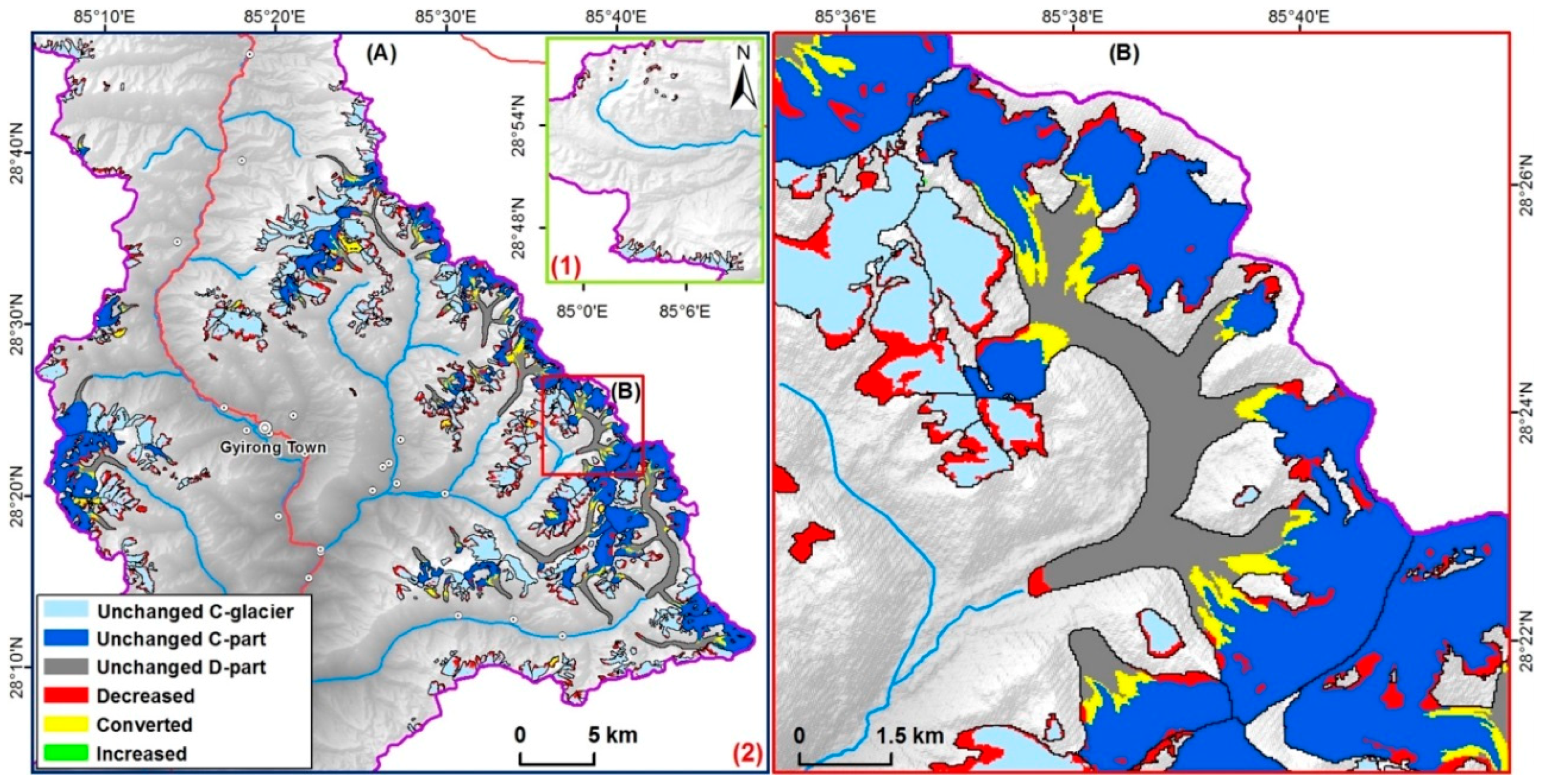
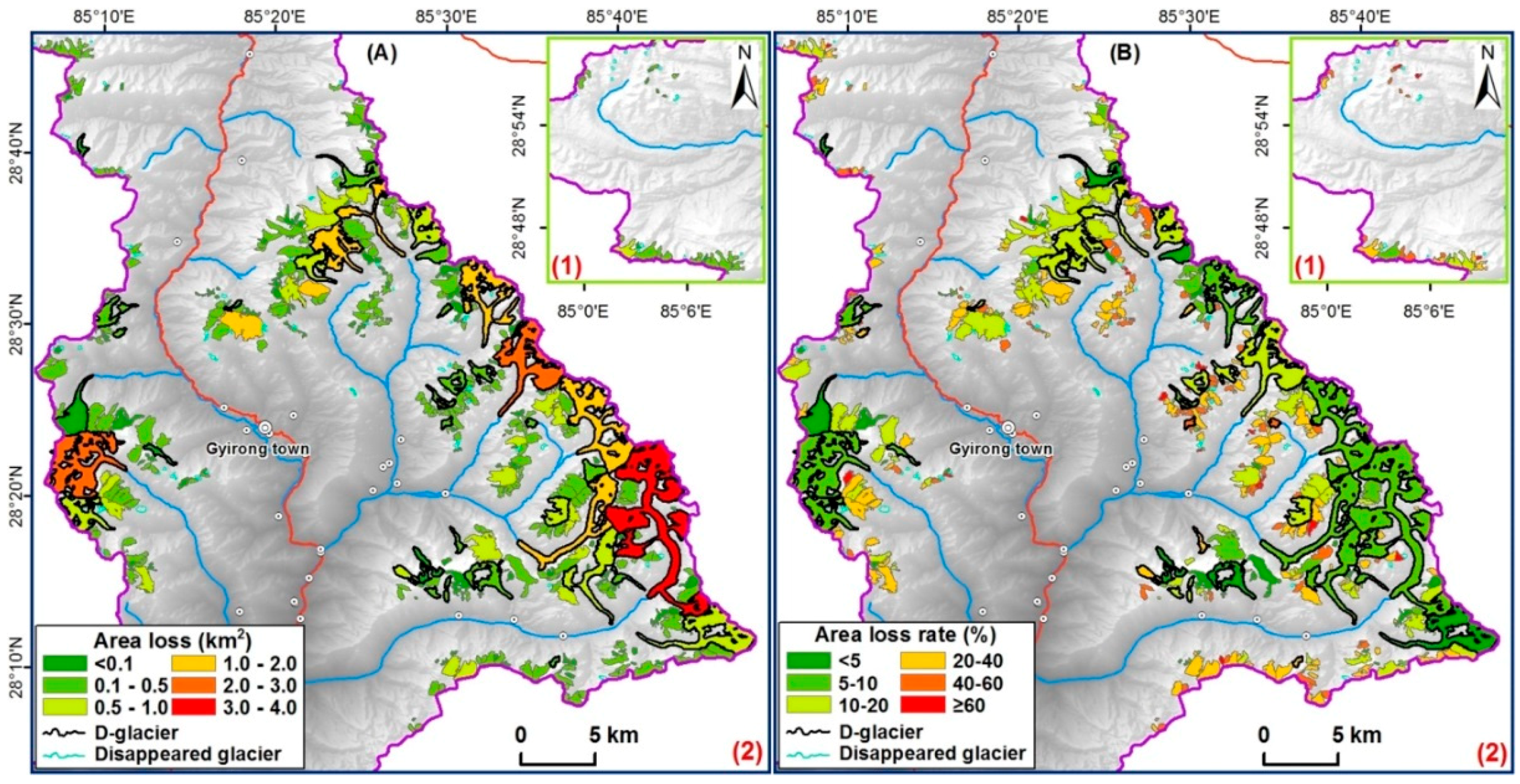

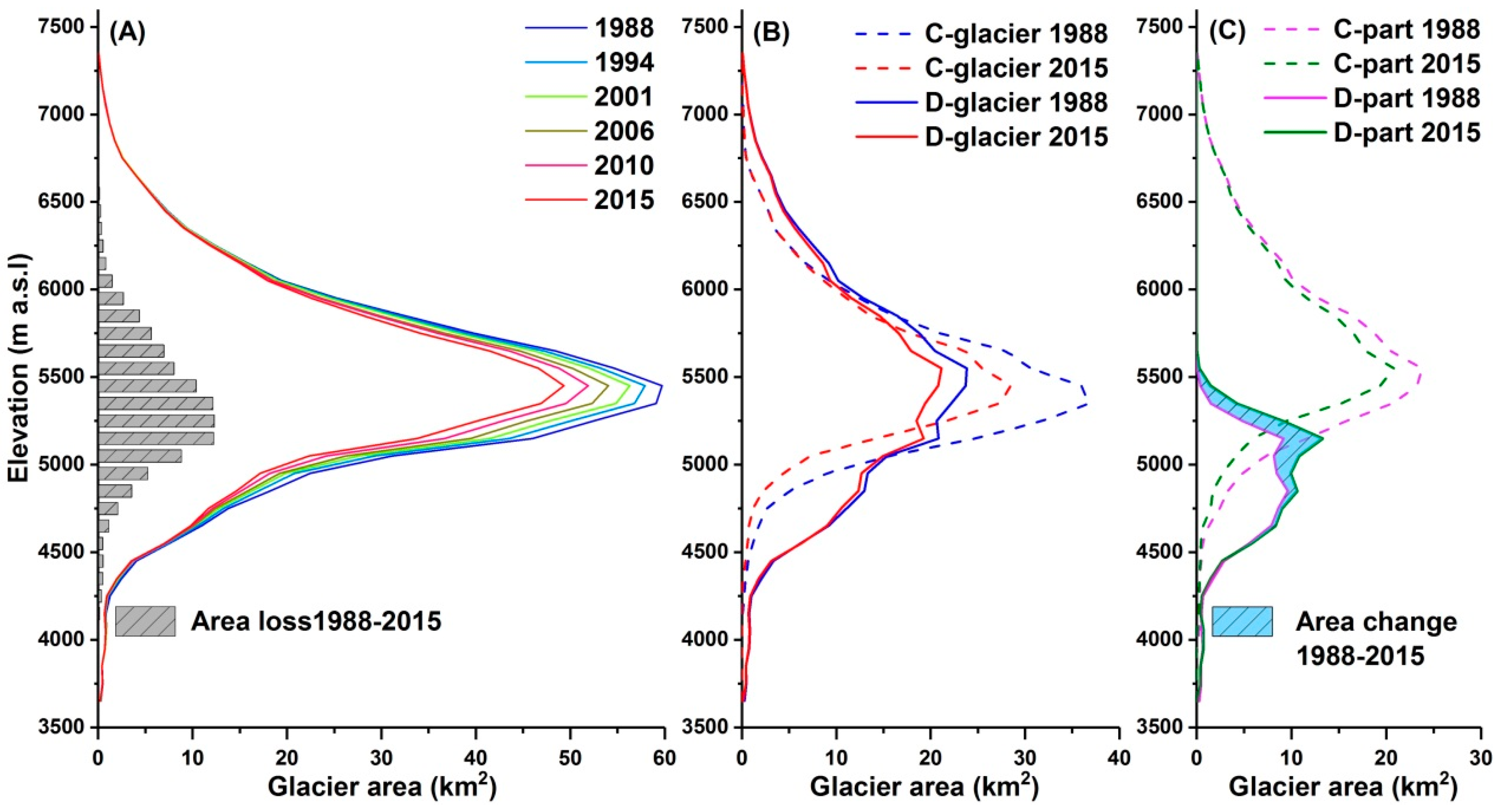
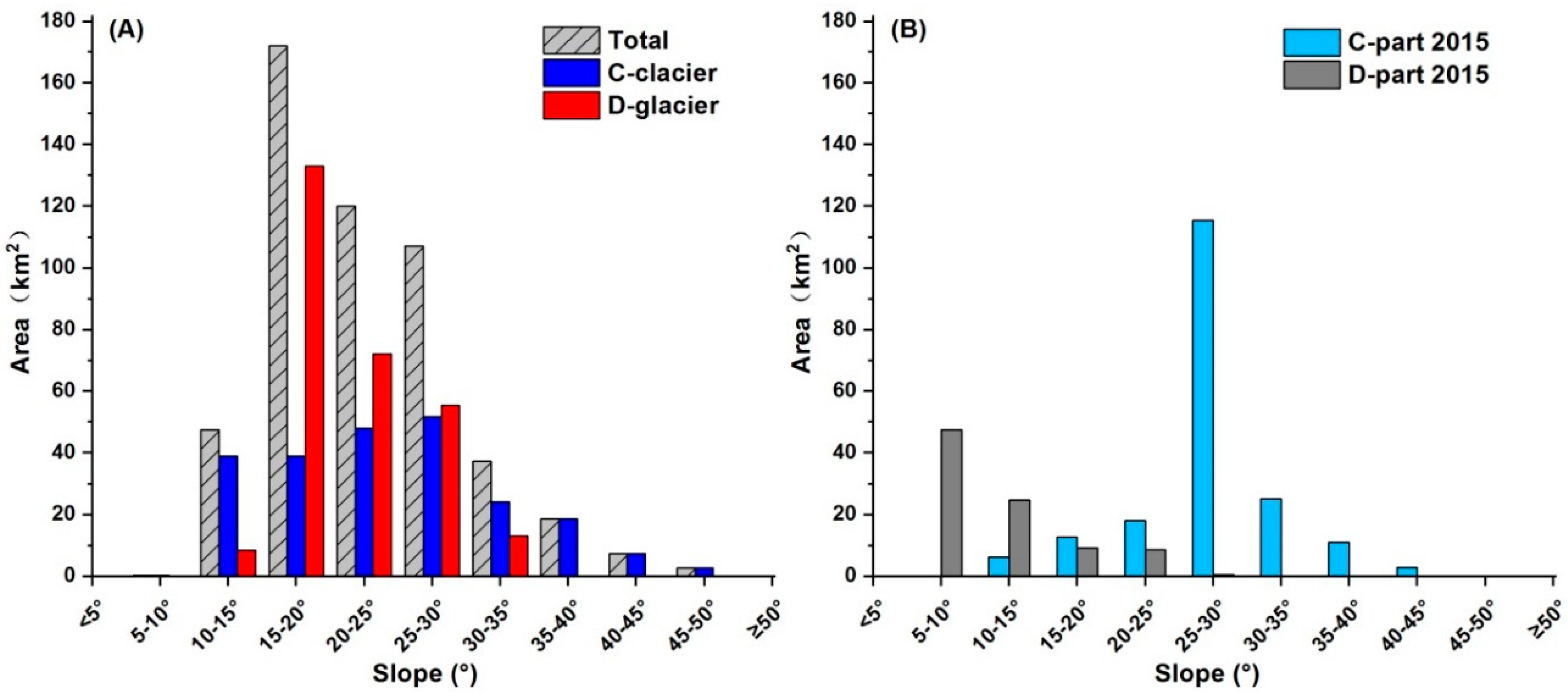


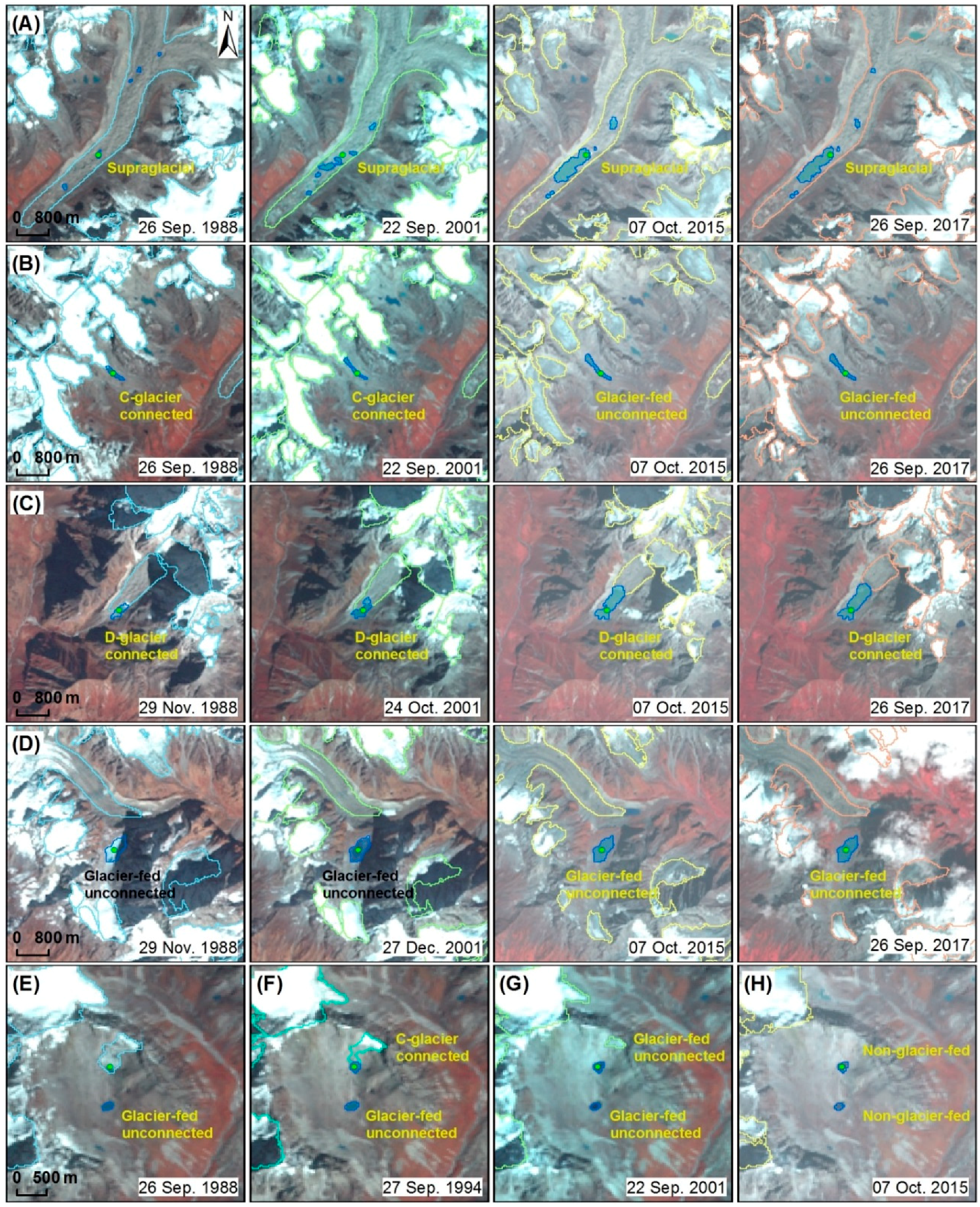

| No. | WRS-2 Path/Row | Satellite/Sensor | Acquisition Date (mm/dd/yyyy) | Thematic Mapping |
|---|---|---|---|---|
| 1 | 141/040 | Landsat 5/TM | 26 September 1988 | Glacier/Lake |
| 2 | 141/040 | Landsat 5/TM | 27 September 1994 | Glacier/Lake |
| 3 | 141/040 | Landsat 5/TM | 27 December 2001 | Glacier/Lake |
| 4 | 141/040 | Landsat 5/TM | 14 October 2006 | Glacier/Lake |
| 5 | 141/040 | Landsat 5/TM | 25 October 2010 | Glacier/Lake |
| 6 | 141/040 | Landsat 8/OLI | 7 October 2015 | Glacier/Lake |
| 7 | 141/041 | Landsat 5/TM | 12 October 1988 | Lake |
| 8 | 141/041 | Landsat 5/TM | 13 October 1994 | Lake |
| 9 | 141/041 | Landsat 5/TM | 27 December 2001 | Lake |
| 10 | 141/041 | Landsat 5/TM | 1 December 2006 | Lake |
| 11 | 141/041 | Landsat 5/TM | 25 October 2010 | Lake |
| 12 | 141/041 | Landsat 8/OLI | 7 October 2015 | Lake |
| 13 | 141/040 | Landsat 5/TM | 29 November 1988 † | Glacier/Lake |
| 14 | 141/040 | Landsat 5/TM | 3 January 1990 † | Glacier/Lake |
| 15 | 141/040 | Landsat 5/TM | 13 October 1994 † | Glacier/Lake |
| 16 | 141/040 | Landsat 7/ETM+ | 24 October 2001 † | Glacier/Lake |
| 17 | 141/040 | Landsat 7/ETM+ | 22 September 2001 † | Glacier/Lake |
| 18 | 141/040 | Landsat 5/TM | 4 March 2006 † | Glacier/Lake |
| 19 | 141/040 | Landsat 5/TM | 28 December 2010 † | Glacier/Lake |
| 20 | 141/040 | Landsat 5/TM | 25 October 2010 † | Glacier/Lake |
| 21 | 141/040 | Landsat 8/OLI | 26 September 2017 † | Glacier/Lake |
| Year | C-Glacier Count (Area, km2) | D-Glacier | Sum Count (Area, km2) | ||
|---|---|---|---|---|---|
| Total Count (Area, km2) | C-Part (km2) | D-Part (km2) | |||
| 1988 | 435 (305.51) | 32 (308.58) | 235.80 | 72.78 | 467 (614.09) |
| 1994 | 432 (289.94) | 32 (304.63) | 226.05 | 78.58 | 464 (594.57) |
| 2001 | 429 (278.24) | 32 (298.98) | 218.19 | 80.79 | 461 (577.22) |
| 2006 | 415 (262.80) | 34 (293.47) | 211.17 | 82.30 | 449 (556.27) |
| 2010 | 402 (248.53) | 37 (288.59) | 203.56 | 85.03 | 439 (537.12) |
| 2015 | 397 (230.94) | 37 (282.13) | 191.56 | 90.57 | 434 (513.07) |
| Period | Count | Area (km2) (Annual Rate (% a−1)) | ||||
|---|---|---|---|---|---|---|
| C-Glacier | D-Glacier | C-Glacier | D-Glacier | C-Part | D-Part | |
| 1988–1994 | −3 | 0 | −15.57 (−0.42) | −3.95 (−0.11) | −9.75 (−0.26) | +5.80 (+0.16) |
| 1994–2001 | −3 | 0 | −11.70 (−0.28) | −5.65 (−0.14) | −7.86 (−0.19) | +2.21 (+0.05) |
| 2001–2006 | −14 | +2 | −15.44 (−0.53) | −5.51 (−0.19) | −7.02 (−0.24) | +1.51 (+0.05) |
| 2006–2010 | −13 | +3 | −14.27 (−0.64) | −4.88 (−0.22) | −7.61 (−0.34) | +2.73 (+0.12) |
| 2010–2015 | −5 | 0 | −17.59 (−0.65) | −6.46 (−0.24) | −12.00 (−0.45) | +5.54 (+0.21) |
| 1988–2015 | −38 | +5 | −74.57 (−0.54) | −26.45 (−0.19) | −44.24 (−0.32) | +17.79 (+0.11) |
| Scenario | Description | Area (km2) |
|---|---|---|
| Unchanged | C-glacier | 226.42 |
| C-part glacier | 190.96 | |
| D-part glacier | 70.01 | |
| Decreased | C-glacier | 76.77 |
| C-part glacier | 21.88 | |
| D-part glacier | 2.58 | |
| Converted | C-part to D-part due to glacial downwasting | 18.57 |
| C-part to C-glacier due to glacial splitting at the upper level | 4.39 | |
| C-glacier to D-part due to glacial downwasting | 1.99 | |
| C-glacier to C-part due to formation of D-part glacier | 0.33 | |
| D-part to C-part due to glacier motion | 0.19 | |
| Increased | C-glacier | 0.13 |
| C-part glacier | 0.07 | |
| D-part glacier from C-part or C-glacier (equivalent to related conversions above) | 20.56 | |
| Total change | C-glacier | −74.57 |
| C-part glacier | −44.24 | |
| D-part glacier | +17.79 |
| Year | Supraglacial | C-Glacier Connected | D-Glacier Connected | Glacier-Fed Unconnected | Non-Glacier-Fed | Total |
|---|---|---|---|---|---|---|
| 1988 | 11 (0.11) | 14 (0.67) | 7 (0.36) | 46 (2.38) | 29 (1.10) | 107 (4.62) |
| 1994 | 20 (0.21) | 14 (0.52) | 7 (0.49) | 53 (2.69) | 29 (1.06) | 123 (4.97) |
| 2001 | 21 (0.26) | 13 (0.39) | 5 (0.41) | 64 (3.04) | 29 (1.06) | 132 (5.16) |
| 2006 | 25 (0.32) | 12 (0.57) | 6 (0.49) | 64 (3.30) | 32 (1.10) | 139 (5.78) |
| 2010 | 23 (0.48) | 10 (0.40) | 6 (0.75) | 71 (3.47) | 32 (1.09) | 144 (6.19) |
| 2015 | 24 (0.55) | 9 (0.77) | 8 (1.00) | 74 (3.56) | 33 (1.24) | 148 (7.12) |
| 1988–2015 | +13 (+0.44) | −5 (+0.10) | +1 (+0.64) | +28 (+1.18) | +4 (+0.14) | +41 (+2.50) |
| Type | 1988 | 1988–2015 | ||
|---|---|---|---|---|
| Count | Area (km2) | Area Loss (km2) | Area Loss Rate (%) | |
| C-glacier connected with lake | 14 | 18.88 | 4.85 | 25.69 |
| C-glacier unconnected with lake | 421 | 286.63 | 69.72 | 24.32 |
| D-glacier connected with lake | 6 a | 40.02 | 4.57 | 11.42 |
| D-glacier unconnected with lake | 26 | 268.56 | 21.88 | 8.15 |
© 2018 by the authors. Licensee MDPI, Basel, Switzerland. This article is an open access article distributed under the terms and conditions of the Creative Commons Attribution (CC BY) license (http://creativecommons.org/licenses/by/4.0/).
Share and Cite
Jiang, S.; Nie, Y.; Liu, Q.; Wang, J.; Liu, L.; Hassan, J.; Liu, X.; Xu, X. Glacier Change, Supraglacial Debris Expansion and Glacial Lake Evolution in the Gyirong River Basin, Central Himalayas, between 1988 and 2015. Remote Sens. 2018, 10, 986. https://doi.org/10.3390/rs10070986
Jiang S, Nie Y, Liu Q, Wang J, Liu L, Hassan J, Liu X, Xu X. Glacier Change, Supraglacial Debris Expansion and Glacial Lake Evolution in the Gyirong River Basin, Central Himalayas, between 1988 and 2015. Remote Sensing. 2018; 10(7):986. https://doi.org/10.3390/rs10070986
Chicago/Turabian StyleJiang, Sheng, Yong Nie, Qiao Liu, Jida Wang, Linshan Liu, Javed Hassan, Xiangyang Liu, and Xia Xu. 2018. "Glacier Change, Supraglacial Debris Expansion and Glacial Lake Evolution in the Gyirong River Basin, Central Himalayas, between 1988 and 2015" Remote Sensing 10, no. 7: 986. https://doi.org/10.3390/rs10070986
APA StyleJiang, S., Nie, Y., Liu, Q., Wang, J., Liu, L., Hassan, J., Liu, X., & Xu, X. (2018). Glacier Change, Supraglacial Debris Expansion and Glacial Lake Evolution in the Gyirong River Basin, Central Himalayas, between 1988 and 2015. Remote Sensing, 10(7), 986. https://doi.org/10.3390/rs10070986







